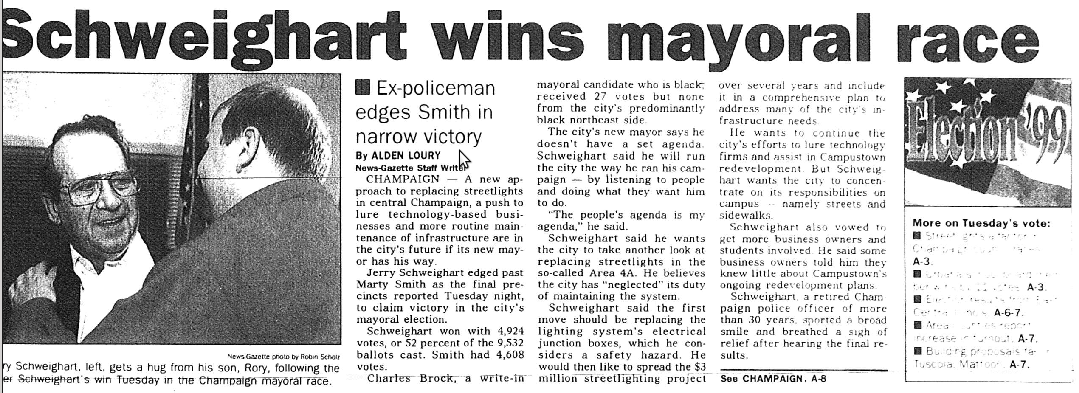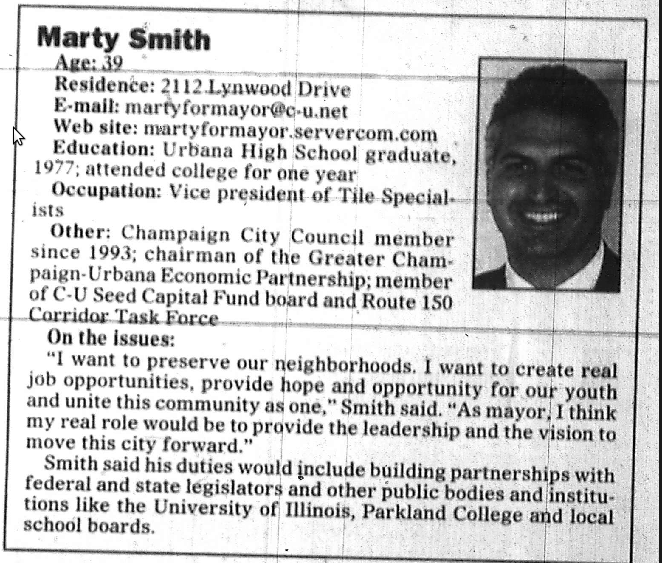
On April 13, 1999, Gerald Schweighart was elected mayor of Champaign. The previous week, Russell Henderson pled guilty to the kidnapping and murder of Matthew Shepard in Laramie, Wyoming. One week after the election, the Columbine school shootings happened.
In other words, it’s been a long damn time since Champaign had a contested mayoral election. To put things in perspective, here are some other facts about April 1999:
- “Believe” by Cher was at the top of the Billboard charts
- Gary Gaetti, having long-ago left his mustache behind, began his last full season of his career at the hot corner for the Chicago Cubs
- Pro wrestler “Ravishing” Rick Rude (at the time, as far as I know, still owner of a fantastic mustache) died
- Wen Ho Lee’s house in Los Alamos, New Mexico, was raided by federal authorities
Meanwhile, in Champaign, Illinois, neither candidate had a mustache, and the electorate was captivated by streetlights. In “Area 4A,” roughly bordered by Mattis, State, Springfield and Washington, the streetlights were in bad shape, apparently requiring swift action on the part of the city. Nearly every newspaper article before and after the election emphasized the importance of the streetlight quandary, almost to the exclusion of any other issue.
 In 1995, Schweighart had run against incumbent Dan McCollum and was soundly defeated by a margin of almost 1,000 votes. McCollum chose to retire rather than seek re-election in 1999, and he threw his support behind Republican Marty Smith, Schweighart’s opponent. Smith, 39 at the time, was vice president of the family business, Tile Specialists, and had been a City Council member since 2003 1993.
In 1995, Schweighart had run against incumbent Dan McCollum and was soundly defeated by a margin of almost 1,000 votes. McCollum chose to retire rather than seek re-election in 1999, and he threw his support behind Republican Marty Smith, Schweighart’s opponent. Smith, 39 at the time, was vice president of the family business, Tile Specialists, and had been a City Council member since 2003 1993.
The News-Gazette also gave its endorsement to Smith, although they bent over backwards to praise Schweighart as well. Schweighart, for his part, was endorsed by then-state representative Tim Johnson and Champaign County Clerk Mark Shelden.
By the time election day rolled around, residents were in such a streetlight-fueled frenzy that voter turnout exceeded 1995 by more than 1,500 votes. Schweighart tallied 4,924 votes (52%) to Smith’s 4,608 (48%). Write-in candidate Charles R. Brock garnered 27 votes.
In the end, Schweighart’s streetlight policy (he was in favor of the city paying to replace the lights, at a cost of $3 million) was cited as a primary reason (according to the N-G, anyway) for his narrow victory over Smith. In contrast, Smith favored residents splitting the cost of streetlight replacement with the city.
In the six precincts that made up Area 4A, Schweighart won by a margin of 1,337 to 868, after losing those same precincts 1,098 to 652 in 1995. Smith won northeast Champaign’s District 1 by a 10-to-1 margin, but low voter turnout in that area kept him from being able to make up much ground.
Political empires have probably had less auspicious beginnings, but I doubt that many Champaign residents would have suggested in 1999 that a 316-vote victory would propel Jerry Schweighart to a 12-year unopposed run as mayor. However, that’s how things worked out. Now, in 2011, in a world where your burned-out streetlight can be reported with the click of a mouse, Champaign gets another opportunity to choose its mayor. Times have changed.
——-
If you’re interested, here are some more time-capsule goodies: a Schweighart campaign ad, Schweighart’s profile, and the N-G editorial endorsing Smith (all pdf’s).








